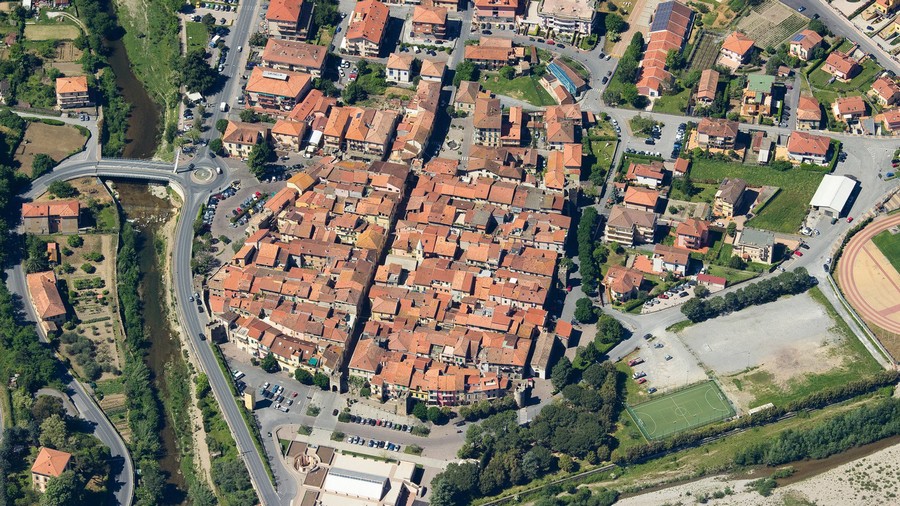Altitude: 29 m a.s.l.
Area: 16 sq km
Distance from Albenga: 7 km
Inhabitants: in 1881: 1268 - in 2017: 2703
Patron Saint Day: December 26th - Santo Stefano
Information: Municipality phone 0182 582913
To defend the territory from the raids of the Marquis of Clavesana, the Municipality of Albenga, between 1250 and 1288, created some fortified villages, including Villanova, whose foundation was approved on 7 December 1250.
The small town was built at the confluence of the Arroscia Valley with the Lerrone Valley, on a strip of land naturally protected by the two water courses and in a strategic position for the control of the communication routes.
From the small settlements of the countryside came the first inhabitants who, having found protection within the walls, were able to better devote themselves to agricultural activities. Villanova suffered several devastations by the Clavesanas, the Dorias and the Spinolas, but remained linked to Albenga until the Ligurian Democratic Institution and later, in 1805, appeared as one of the municipalities of the Circumscription and, with a royal decree of 1863, assumed the name of Villanova d'Albenga.
The village is enclosed within the ancient city walls almost completely preserved. The walls rise to over seven meters in height and are surmounted by Guelph battlements.
Along the perimeter there are ten imposing towers of different shapes, six at the corners of the village and four at the cardinal points; the two located at the ends of Via Garibaldi serve as city gates.
A single road crosses the town in a horizontal direction and twelve alleys open orthogonally on it, creating rectangular blocks.
The ancient medieval well rises in a central position: built after the foundation of the village, it remained in use until the 1930s, supplying drinking water to all the inhabitants of Villanova.
Visit of the town
The function of Villanova as a defensive and shelter location for the inhabitants of the area, explains its position closed on three sides by the torrents Arroscia (north and east) and Lerrone (south) and the subsequent construction of walls and towers around the village.
This conformation made Villanova a bulwark that could hardly be conquered by enemies coming from the nearby fiefdoms of the Clavesanas and the Della Lengueglias.
With the founding act of Villanova d'Albenga, the construction of fortification walls around the village was also established.
The walls were built with river pebbles and raised for more than seven meters with a one meter thickness and an internal gap that allowed to create the walkway for rounds.
In 1921 was approved the demolition of some unsafe sections of the walls and the opening of gates for a better access to the village and higher hygiene.
However, the ten square-plan towers of the city walls can still be visited in the historic center, all of which open to the interior of the village and are arranged on two floors. Originally there was an eleventh tower that was probably incorporated into the Oratory of San Giovanni Battista.
The village develops along the present day Via Garibaldi, a central axis about 151 meters long and 6 meters wide, on which opens a widening in which the medieval well is located: perpendicular to the central street open the side alleys once having a drainage channel for rainwater.
The townhouses of the village were characterized by open terraces called "truvine" or covered loggias, and internally by a fireplace with masonry seats on the sides.
All this medieval structure can still be found today; having reached the center of the village the medieval well is there to confirm the history of this ancient town. Until the thirties of the twentieth century it supplied the inhabitants of Villanova with drinking water: elliptical and made of alveolar sandstone, it seems to have been built towards the end of 1200.
The upper part of the pulley support is a single piece of iron in the shape of a yoke and is adorned with pine cone elements.
The side hooks served as a support for the ladle with which water was drawn from oval bronze buckets.
Villanova d'Albenga is famous for the cultivation of violets; not by chance, a bunch of violets is represented in the municipal emblem right next to the towers and the town is called "Paese delle Violette" (i.e. the town of violets).
The cultivation of this fragrant and unmistakable flower is handed down from the second half of the last century from generation to generation: of French importation, the cultivation of violets gives its best thanks to the particular microclimate that allows this niche cultivation and ensures an exceptional fragrance and duration of the flower (the flowering period begins around October 20 to end at the end of March). In May and July are cut the leaves used in the perfume industry.
The most evocative of the Villanova events is the Good Friday procession, during which the statue of Christ is carried by men who rest it on their thighs and walk at a measured pace; in the church then takes place the singing of the Passion according to a composition handed down from generation to generation.
On June 24, for the floral display of San Giovanni, the whole village is decorated with boughs and blooming branches.
The summer evenings are animated by the “Sagra dei Caruggi”, where you can taste the typical specialties of the west Ligurian hinterland, and by the characteristic Historical Re-enactment.


